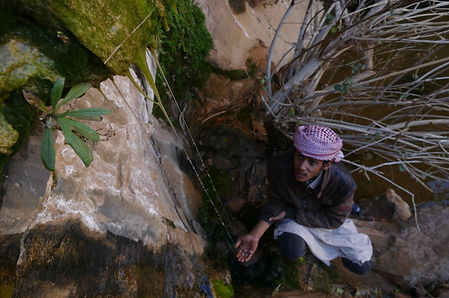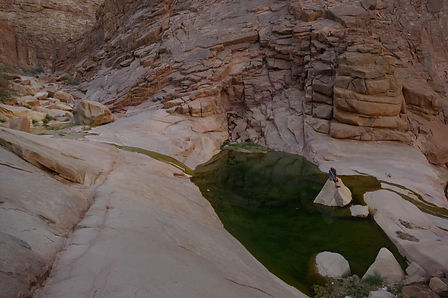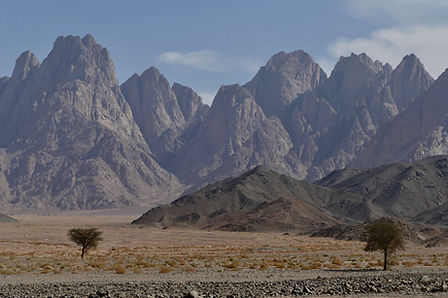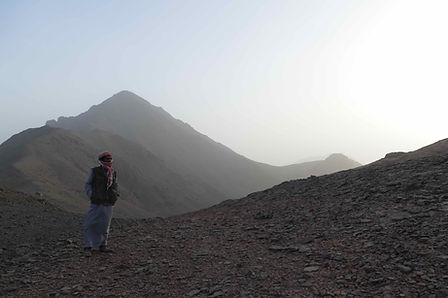El Gattar: Overview
Jebel Gattar is one of the greatest-kept secrets of Egypt's vast desert wilderness. A gigantic labyrinth of granite peaks and winding ravines, there is no place like it in Egypt; perhaps even the world. Jebel Gattar does not refer to a single summit, but to a bigger massif with different districts. Gigantic horns, pinnacles, teeth and fangs tower high in some areas - giving Jebel Gattar an aggressive, foreboding feel - whilst in others, whaleback summits and high, rounded domes give it a more gentle character. Mountain scenery like this stands unparalleled on the Red Sea Mountain Trail. Its wadis, gorges and ravines are just as magical too. Deep, green pools of water gather here and for months after rain and creeks trickle between them through dense thickets of greenery. Jebel Gattar is home to mountain springs that never run dry. This mountain is the proverbial heart of the region. For millennia, its water has sustained the people and animals of this harsh desert. Wherever you wander, Jebel Gattar has a wild, lost world feel; age old leopard traps stand on high passes and prehistoric graffiti shows giraffes and ibex. Some 2000 years ago, it was into the wilds of Jebel Gattar that Egypt's Christians scattered to escape the persecutions of the Roman Empire. Today, their hermit cells and chapels are still found hidden in the high crags and wadis. Jebel Gattar is the crown jewel of the Red Sea Mountain Trail and home to one of its most spectacular hiking hubs. It is a must-see district of the trail. World class scenery unfolds here at every turn. Nevertheless, hiking the region is not easy; there are no trails. Everything is off-trail and steep, exposed scrambling is sometimes involved. Getting here takes about two hours each way by 4x4 from Hurghada.















Highlights
Wadi Nagaata

Wadi Nagaata is one of the most beautiful wadis of Jebel Gattar. It takes its name from a high, dripping spring called El Nagaata, where water trickles through cracks in the granite cliffs to collect in a small pool. A green tongue of mosses, ferns and grasses hangs down the water line and wild fig trees grow at the bottom. Thousands of years ago, some of Egypt's early Christians, the so-called Desert Fathers, scattered to Wadi Nagaata to escape the Roman Empire's persecutions and their chapels and hermit cells are found along the wadi today. Palm trees, leopard traps, water pools and rock art are other attractions. The wadi can be hiked over a few hours or integrated into a bigger circuit, including an ascent of one of Jebel Gattar's peaks.
Wadi Um Deesa

Um Deesa is another one of Jebel Gattar's dripping springs. As with El Nagaata, water seeps out through cracks, in the cliffs, nourishing a tumble of green vegetation. Water collects in a pool at the bottom, which in wetter times overspills to form a chain of connected pools that dot the wadi over several kilometres. Lush thickets of grass and bamboo grow and gigantic acacia trees rise in the wadi's lower stretches. Leopard traps, prehistoric burial grounds and rock art are all found nearby and the area is rich in Bedouin fable and legend. Some Bedouin say the region is haunted by a girl who drowned in one of the pools. Um Deesa can be hiked in a circuit with Wadi Ghuza and a hike over Jebel Gattar connects it with El Nagaata.
Jebel Gattar

Jebel Gattar has many summits, most of which can only be scaled with technical rock climbs. The most accessible is a high whaleback summit on its westerly side. From the top, views open to other spectacular parts of the Jebel Gattar massif and over vast, sweeping deserts to the faraway tablelands of the Nile Valley. Getting up this summit is mostly a long, rugged hike, although there is the optional challenge of scrambling up a high, upstanding rock finger on the top. This summit can be completed in a long day, starting near the dripping spring of Um Deesa and finishing near El Nagaata, but it is best done over two, with a bivvy on top. In a small basin below the peak is a cave that gives excellent overnight shelter on a two day hike.
Jebel Kohla

Jebel Kohla rises in the massif of Jebel Gattar, but has a different look to the surrounding highlands. Whilst most of Jebel Gattar is red granite, Jebel Kohla is a black rock pyramid. Kohl is a kind of dark eyeshadow used across the Middle East and it gives the mountain its name. Jebel Kohla's summit is marked by a tall cairn and on a clear day gives far-reaching views over the Red Sea to the summits of the Sinai. The deep, winding gorge of Wadi Ghuza and the Plain of Um Anfia are seen below too. There are no trails up Jebel Kohla. It is best climbed by following its summit ridge. From Wadi Thilma, its south ridge can be followed to the summit and its north ridge descended to rugged crags that lead down to the Plain of Um Anfia.

